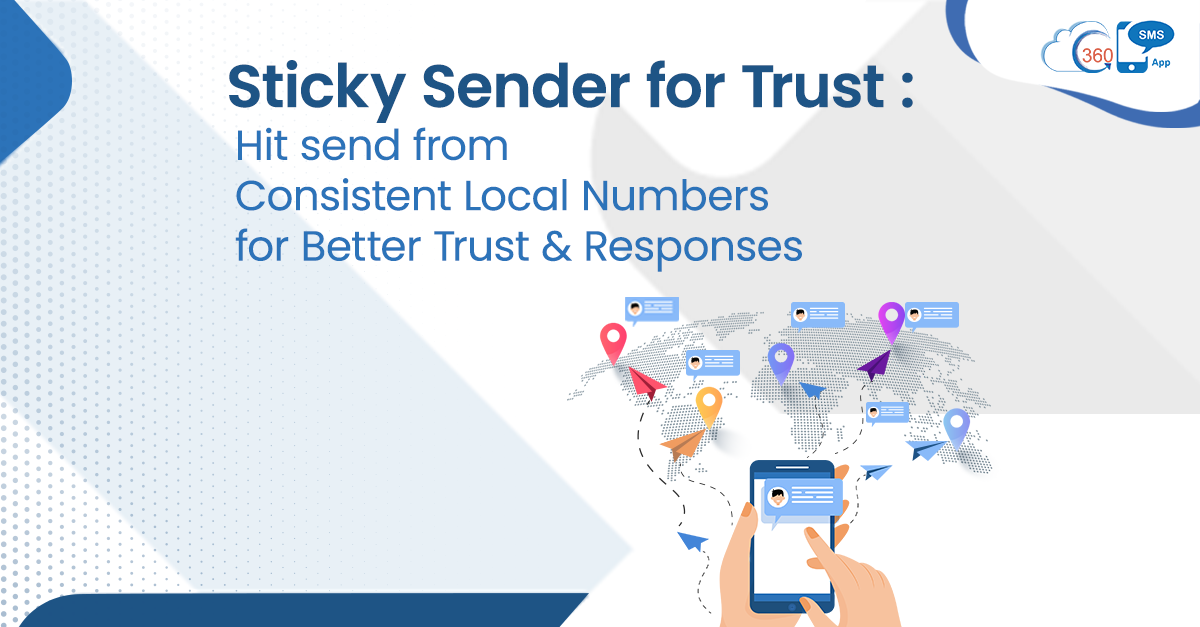Sticky Sender for Trust: Hit send from consistent Local Numbers for better trust & responses
Studies have shown that customers are more likely to respond to local numbers rather than non-local ones. So, nothing can be as good as reaching customers with more trustworthy local numbers. Keeping manual efforts to minimal, 360 SMS’ Sticky Sender feature provides feasibility to handle the uphill task of winning customers’ confidence through a local number and attract more responses in no time.
Keeping aside the hassle of finding the last sender number, the feature does this task itself for you and saves heaps of time and effort.
Bridging trust right from the first message
Multiple sender numbers can put a user into a skeptical situation, making it tough to recall the past conversation. As a result, advantages that come with a consistent point of contact usually fade away. So, taking prospects’ perception seriously, Sticky Sender allows you to reap the benefits of a single number usage while conversing with a specific client. With consistent sender details, it is much easier to get responses from clients without bringing forth any trust issues.
Let’s find out how this feature can be a valuable asset to reap the benefits of texts across verticals.
Local numbers mean higher trust
It is always challenging to gauge people’s interests scattered in different regions and build trust in your offerings. But a single point of contact can help you from start-to-end of your trust-building journey.
Let’s understand this through an example:
If you are looking to target audiences from three different regions of the USA, then reaching them out and conversing using just one number, irrespective of the region, will not be going to work due to inconsistency.
Thus, for targeting three different regions like Alaska, California, and Washington, you’d need three local numbers for seamless future conversations. And even if you are sending the same message to all customers, you need to go through a repetitive process thrice for three different locations.
A look at the ‘Sticky Sender’ In-use
In this concern, Sticky Sender helps you the best with its functionality. By eliminating repetitive tasks, the feature automatically fetches different designated local sender numbers used for sending the first message.
Therefore, even if you are sending bulk messages, it will automatically use designated numbers driving down your manual efforts. You do not need to select local numbers separately for different cities or regions and double up your tasks.
Sticky Sender is well-acquainted to use contact numbers smartly while connecting a specific client from a specific region. Your clients always receive SMS from the local number as Sticky Sender picks up the last sender number used to contact a client.
For Example:
1st message
Hey Bob
Do you have any loan requirements at affordable interest rates? Please let us know the kind of loan you are looking for.
Based on the customer’s reply, you can send the next text.
2nd message
Here are EMI plans and interest rate details as per your requirement
The second message can be a bit disorienting for the client if it is sent from a different number. Also, it might be difficult for the client to recall the past conversation instantly.
But Sticky Sender’s ability to reach customers with a consistent number will sort things out and help obtain a much faster response.
Choosing sender numbers dynamically is now feasible
Targeting geographically dispersed audiences through text demands more time investment.
It’s because executives need to select local numbers manually to communicate through local numbers and put extra effort into each target country. But Sticky sender has made it feasible to stick to a single throughout the conversation. Even if you are sending messages in bulk, it auto-selects the local number based on the origin country of prospects. Thus, employees do not need to select the relevant sender number manually, which cuts back on a lot of busy work. Else, this would only increase employee’s workload and hamper their efficiency.







